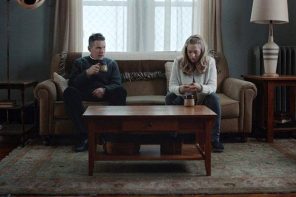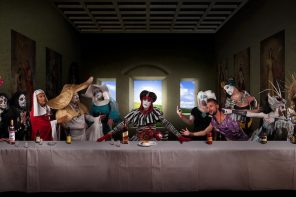We are living in Bonhoeffer times, my friend. Bonhoeffer times.
—Rev. Dr. Andrew J. Weaver
There is a break in a rail of the old tracks by a platform where Jews were once loaded on cars for their trip to Auschwitz. In the film Elisabeth of Berlin, the camera lingers on this detail. The break in the tracks seems to suggest what the power of Christian conscience might have meant, and what it could mean for a society heading in the wrong direction.
Elisabeth of Berlin, a 59-minute independent documentary by Rev. Steven D. Martin, a Methodist minister from Oak Ridge, Tennessee, highlights the story of a woman who died in obscurity, but lived a life now celebrated by leading Christian thinkers. Scholars of the anti-Nazi resistance are astonished by what Elisabeth Schmitz did and the risks she took—she fits, one says in the film, “the Protestant definition of a saint.” But until 2004, not only were her life and work largely unknown but her most remarkable act had been mistakenly attributed to someone else.
Film director Steven D. Martin has now made three films about the role of the church during the Holocaust. He premiered Elisabeth of Berlin at churches in Berlin and Hanau on the 70th anniversary of Kristallnacht this last November. He is currently making public appearances with the film and seeking to get it on public or cable television.
Martin says he sees his films as “parables” that allow the church of today to consider what kind of church it needs to be. “There is something fundamentally anti-Christian about trying to save your rear end,” he asserts. The scriptures themselves give us the model for a different kind of life, he explains: “I want a church that sees things clearly and is ready to act when it’s necessary.”
“Elisabeth Schmitz was very clear about seeing where the dangers are,” Martin concludes, “and she wanted everyone to wake up.”
Lifting the Fog of History
Schmitz was one of the first women in Germany to earn a PhD from the prestigious Humboldt University in Berlin. In 1935, she authored a secret and anonymous call to Christian conscience about the church’s responsibility to the Jews. The anonymity was prudent, because authorship of “On the Predicament of the German non-Aryans” could have landed her in a concentration camp. The same fate would have befallen any church leaders found to have it in their possession.
Due to a quirk of history, the paper was until recently attributed to a fellow member of the anti-Nazi resistance, Marga Meusel. A friend of Elisabeth’s, Dietgard Meyer, tried to set the record straight in 1998, but it wasn’t until 2004 that the material evidence emerged—Schmitz’s first draft surfaced in a church basement in her hometown of Hanau, near Frankfurt. We meet the man who found it and get a look at her cursive manuscript and teacherish red-ink revisions. (The scholarship on this subject is still so fresh that as of this writing, the paper is still attributed to Meusel in Wikipedia’s entry on The Confessing Church.)
Written over the course of a year, she put the paper into final form on a manual typewriter, and secretly mimeographed 200 copies of the 24-page manifesto in 1936. According to the film, she wanted to provide church leaders, “with a document so clear, so convincing, that there would be no choice but to speak out, to mobilize on behalf of Jews across Germany.”
Professor Martin Greschat says in the film that The Confessing Church, and even radicals like Bonhoeffer, thought that the fate of the Jews was “the problem of the state” unless they had been baptized as Christians. That, Schmitz insisted, was just not good enough: “We must, as Christians,” she declared, “act for all the Jews as much as is our possibility.”
“How are we to answer the many desperate, bitter questions and complaints?” Schmitz demanded to know. “Why doesn’t the Church do anything? Why does it permit the nameless injustices to go on? How can it time and again pay joyous tribute to the National Socialists and offer political endorsements to a government that persecutes some of its own members? Why does it not at least protect the children? How could it be that everything that is simply incompatible with the nowadays much maligned humaneness could be compatible with Christianity?”
For his part, Deitrich Bonhoeffer, after being kept to the margins by church leaders of the time, was rehabilitated and even celebrated after the war by a church seeking to show that they were not as complacent or complicit as Schmitz had charged. Bonhoeffer played a low-level role in the 1943 military plot to assassinate Hitler, and was hanged at Flossenbürg, a concentration camp.
Kristallnacht Changed Everything
Schmitz is said to have observed in 1938, when the Nazis marked and destroyed Jewish-owned property, that it was just a matter of time before the same would be done to the people who owned the property. Her predictions were dramatically borne out in November 1938, when a coordinated Nazi attack resulted in the destruction of synagogues, the murder of nearly one hundred people, and the deportation of 25,000 to concentration camps—Kristallnacht.
She wrote to the minister of her prominent Berlin church, urging him to speak out. He did, but there were few others. “The Dahlem congregation in Berlin was one of the most outspoken parts of the Confessing Church,” Bishop Huber explains in the film. “And it’s very moving for me that she wrote letters to Helmut Gollwitzer, who was a good friend of mine, personally. And his sermon after the so-called Reichskristallnacht pogroms of 9th and 10th of November 1938 was one of the two most important sermons which were given in German in the whole country! In the whole country, not only Berlin.”
Professor Andreas Pangritz of the University of Bonn adds that Gollwitzer’s “Repentance Day” sermon has been celebrated as “one exceptional statement by a theologian of the Confessing Church in solidarity with the Jews.” But he adds that “most theologians of the Confessing Church remained silent in this situation. The film reports, for example, that “Luther scholar Paul Althaus announced Hitler’s rise to power as ‘A gift and miracle of God.’ Theologian Emanuel Hirsch announced it as a ‘sunrise of divine goodness.’ Gerhard Kittel, a leading Christian New Testament scholar, gave a speech in 1933 in which he offers possible solutions to ‘the Jewish Question,’ including deportation and extermination of the entire race.”
Schmitz resigned her job as a high school teacher of German, history, and religion after Kristallnacht, because she could no longer bring herself to teach in a school that emphasized Nazi ideology. No one knows precisely what Schmitz did from 1938 until 1943, aside from her ongoing efforts to shelter Jews. In 1943 she returned to Hanau to help care for her aging parents. She died in obscurity in 1977. Only seven people attended her funeral.
+++
Short Section from Elisabeth of Berlin from Steve Martin on Vimeo.



